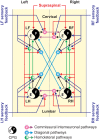The neural control of interlimb coordination during mammalian locomotion
- PMID: 28298308
- PMCID: PMC5454475
- DOI: 10.1152/jn.00978.2016
The neural control of interlimb coordination during mammalian locomotion
Abstract
Neuronal networks within the spinal cord directly control rhythmic movements of the arms/forelimbs and legs/hindlimbs during locomotion in mammals. For an effective locomotion, these networks must be flexibly coordinated to allow for various gait patterns and independent use of the arms/forelimbs. This coordination can be accomplished by mechanisms intrinsic to the spinal cord, somatosensory feedback from the limbs, and various supraspinal pathways. Incomplete spinal cord injury disrupts some of the pathways and structures involved in interlimb coordination, often leading to a disruption in the coordination between the arms/forelimbs and legs/hindlimbs in animal models and in humans. However, experimental spinal lesions in animal models to uncover the mechanisms coordinating the limbs have limitations due to compensatory mechanisms and strategies, redundant systems of control, and plasticity within remaining circuits. The purpose of this review is to provide a general overview and critical discussion of experimental studies that have investigated the neural mechanisms involved in coordinating the arms/forelimbs and legs/hindlimbs during mammalian locomotion.
Keywords: central pattern generator; interlimb coordination; locomotion; propriospinal; somatosensory; spinal cord injury; supraspinal.
Copyright © 2017 the American Physiological Society.
Figures


Similar articles
-
Control of Forelimb and Hindlimb Movements and Their Coordination during Quadrupedal Locomotion across Speeds in Adult Spinal Cats.J Neurotrauma. 2022 Aug;39(15-16):1113-1131. doi: 10.1089/neu.2022.0042. Epub 2022 May 6. J Neurotrauma. 2022. PMID: 35343245 Free PMC article.
-
Interlimb Coordination during Tied-Belt and Transverse Split-Belt Locomotion before and after an Incomplete Spinal Cord Injury.J Neurotrauma. 2017 May 1;34(9):1751-1765. doi: 10.1089/neu.2016.4421. Epub 2016 Jun 27. J Neurotrauma. 2017. PMID: 27219842
-
Spatiotemporal control of interlimb coordination during transverse split-belt locomotion with 1:1 or 2:1 coupling patterns in intact adult cats.J Neurophysiol. 2014 Oct 15;112(8):2006-18. doi: 10.1152/jn.00236.2014. Epub 2014 Jul 23. J Neurophysiol. 2014. PMID: 25057143
-
Regulation of arm and leg movement during human locomotion.Neuroscientist. 2004 Aug;10(4):347-61. doi: 10.1177/1073858404264680. Neuroscientist. 2004. PMID: 15271262 Review.
-
Do human bipeds use quadrupedal coordination?Trends Neurosci. 2002 Sep;25(9):462-7. doi: 10.1016/s0166-2236(02)02229-4. Trends Neurosci. 2002. PMID: 12183207 Review.
Cited by
-
Analytical CPG model driven by limb velocity input generates accurate temporal locomotor dynamics.PeerJ. 2018 Oct 8;6:e5849. doi: 10.7717/peerj.5849. eCollection 2018. PeerJ. 2018. PMID: 30425886 Free PMC article.
-
Delayed muscle onset soreness in the gastrocnemius muscle attenuates the spinal contribution to interlimb communication.Eur J Appl Physiol. 2018 Nov;118(11):2393-2402. doi: 10.1007/s00421-018-3966-0. Epub 2018 Aug 21. Eur J Appl Physiol. 2018. PMID: 30132112
-
Assessing the spatial distribution of cervical spinal cord activity during tactile stimulation of the upper extremity in humans with functional magnetic resonance imaging.Neuroimage. 2020 Aug 15;217:116905. doi: 10.1016/j.neuroimage.2020.116905. Epub 2020 May 6. Neuroimage. 2020. PMID: 32387628 Free PMC article.
-
Fine-grained descending control of steering in walking Drosophila.bioRxiv [Preprint]. 2023 Oct 30:2023.10.15.562426. doi: 10.1101/2023.10.15.562426. bioRxiv. 2023. Update in: Cell. 2024 Oct 31;187(22):6290-6308.e27. doi: 10.1016/j.cell.2024.08.033. PMID: 37904997 Free PMC article. Updated. Preprint.
-
Long-term clinical observation of patients with acute and chronic complete spinal cord injury after transplantation of NeuroRegen scaffold.Sci China Life Sci. 2022 May;65(5):909-926. doi: 10.1007/s11427-021-1985-5. Epub 2021 Aug 16. Sci China Life Sci. 2022. PMID: 34406569
References
Publication types
MeSH terms
LinkOut - more resources
Full Text Sources
Other Literature Sources

